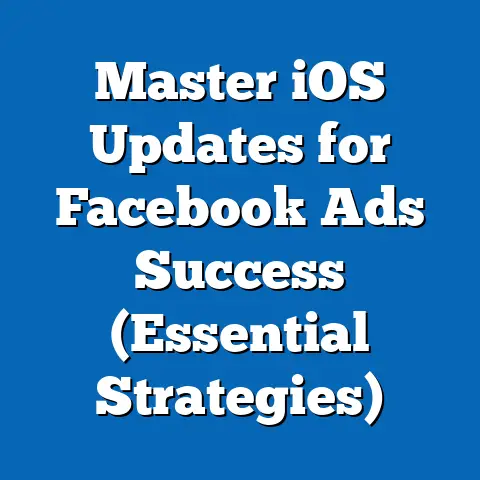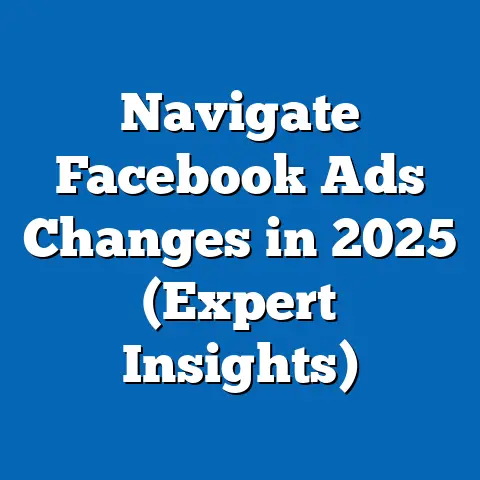Unlock Geofencing Facebook Ads (Maximize Local Impact)
Have you ever walked past a coffee shop and suddenly received an ad on your phone for a discount latte? Or maybe you were near a competitor’s store when an enticing offer from a nearby business popped up on your Facebook feed. This isn’t magic; it’s the power of geofencing combined with the reach of Facebook Ads. I’ve seen firsthand how this technology can transform a local marketing strategy from a shot in the dark to a laser-focused, revenue-generating machine. In this article, I’ll delve deep into the world of geofencing Facebook Ads, showing you how to maximize your local impact, drive foot traffic, and ultimately, boost your bottom line.
Section 1: Understanding Geofencing
Geofencing is a location-based service that defines a virtual perimeter around a real-world geographic area. Think of it as drawing a digital fence on a map. When a mobile device enters or exits this “fenced” area, it can trigger a pre-programmed action, such as sending a notification, an email, or, in our case, displaying a Facebook ad. It’s essentially saying, “When someone is here, do this.”
Defining Geofencing and its Relevance in Digital Marketing
In the crowded digital marketing landscape, where businesses are constantly vying for attention, geofencing offers a unique edge. It allows you to target potential customers based on their real-time location, delivering highly relevant and timely messages. This precision targeting is crucial for local businesses looking to attract nearby customers. I remember working with a local bakery that was struggling to attract lunch customers. By implementing a geofencing campaign targeting people within a one-mile radius during lunchtime, we saw a significant increase in foot traffic and, more importantly, sales.
How Geofencing Works: GPS Technology and Mobile Device Tracking
Geofencing relies on a combination of technologies, primarily GPS (Global Positioning System) and cellular triangulation.
-
GPS: Most smartphones have built-in GPS receivers that can pinpoint their location with remarkable accuracy. This is the most precise method, allowing for very small geofence radii.
-
Cellular Triangulation: This method uses the signal strength from nearby cell towers to estimate a device’s location. It’s less accurate than GPS but can still be effective, especially in areas where GPS signals are weak or unavailable.
-
Wi-Fi Positioning: By analyzing the Wi-Fi networks a device can detect, its location can be estimated based on known Wi-Fi hotspot locations.
GPS: Most smartphones have built-in GPS receivers that can pinpoint their location with remarkable accuracy. This is the most precise method, allowing for very small geofence radii.
Cellular Triangulation: This method uses the signal strength from nearby cell towers to estimate a device’s location. It’s less accurate than GPS but can still be effective, especially in areas where GPS signals are weak or unavailable.
Wi-Fi Positioning: By analyzing the Wi-Fi networks a device can detect, its location can be estimated based on known Wi-Fi hotspot locations.
Mobile apps and operating systems request location permissions from users. When granted, these apps can continuously monitor the device’s location and trigger actions when it enters or exits a geofence.
The Evolution of Location-Based Advertising
Location-based advertising has come a long way. It started with simple SMS-based promotions sent to users in a particular area. Then came location-aware mobile apps that could offer deals and recommendations based on your current location. Geofencing represents the next evolution, offering even greater precision and control over targeting.
The emergence of geofencing as a tool for businesses is tied to the increasing sophistication of mobile technology and the growing importance of mobile advertising. With more and more people using their smartphones as their primary source of information and entertainment, businesses need to be where their customers are – on their phones, in the right place, at the right time.
Takeaway: Geofencing is a powerful location-based marketing tool that allows you to target potential customers with relevant ads based on their real-time location. Understanding how it works is the first step to leveraging its potential.
Section 2: The Power of Facebook Ads
Facebook Ads are a cornerstone of modern digital marketing. With billions of active users, Facebook provides unparalleled reach and targeting capabilities, making it an essential platform for businesses of all sizes.
Overview of Facebook Ads: Reach and Effectiveness
Facebook’s advertising platform is incredibly versatile, allowing you to create a wide range of ad formats, from simple image ads to engaging video ads and interactive experiences. But the real power of Facebook Ads lies in its targeting options. You can target users based on their demographics, interests, behaviors, and even their connections.
The reach of Facebook Ads is simply staggering. As of Q4 2023, Facebook has 3.07 billion monthly active users worldwide. This massive audience provides businesses with the opportunity to reach a huge number of potential customers.
Facebook Advertising Statistics in Local Markets
Facebook’s advertising power is particularly evident in local markets. According to a study by Statista, 64.4% of consumers use Facebook to find local businesses. This means that a significant portion of your target audience is already using Facebook to discover and connect with businesses in their area.
Here are some key statistics that highlight the effectiveness of Facebook Ads in local markets:
- Local Awareness Ads: These ads are specifically designed to reach people near your business, making them ideal for driving foot traffic.
- Mobile Advertising: A large percentage of Facebook users access the platform via mobile devices, making mobile advertising incredibly effective for reaching local customers on the go.
- Cost-Effectiveness: Facebook Ads can be a cost-effective way to reach a large audience compared to traditional advertising methods like print or television.
I remember helping a local restaurant in my neighborhood revamp their Facebook Ads strategy. By focusing on local awareness ads and targeting users within a 5-mile radius, we saw a 40% increase in reservations in just a few weeks. It was a clear demonstration of the power of Facebook Ads in driving local business.
Enhancing Facebook’s Targeting Capabilities with Geofencing
While Facebook’s native targeting options are powerful, they can be taken to the next level by integrating geofencing. Instead of just targeting people who live in a certain city or have an interest in a particular topic, you can target people who are physically present in a specific location.
This combination of Facebook’s broad reach and geofencing’s precision targeting creates a synergistic effect. You can reach a larger audience while ensuring that your ads are only shown to people who are most likely to be interested in your offer.
Takeaway: Facebook Ads provide unparalleled reach and targeting capabilities, especially in local markets. By integrating geofencing, you can enhance these capabilities and deliver highly relevant ads to potential customers based on their real-time location.
Section 3: How Geofencing Works with Facebook Ads
Setting up geofencing for Facebook Ads involves a combination of technical steps and strategic planning. You’ll need to define your target areas, create compelling ad content, and configure your Facebook Ads Manager settings to leverage location-based targeting.
Setting Up Geofencing for Facebook Ads: Technical Steps and Best Practices
Here’s a step-by-step guide to setting up geofencing for Facebook Ads:
- Define Your Target Area: Identify the specific geographic areas you want to target. This could be around your business location, a competitor’s store, a local event, or any other relevant location.
- Create a Custom Audience: In Facebook Ads Manager, create a custom audience based on location. You can define a radius around a specific address or drop a pin on a map to create a geofence.
- Choose Your Ad Objective: Select an ad objective that aligns with your goals, such as “Reach,” “Traffic,” or “Conversions.” For local businesses, “Store Traffic” is a particularly relevant objective.
- Create Compelling Ad Content: Craft ad copy and visuals that are relevant to the location you are targeting. Highlight nearby locations, local events, or special offers for customers in the area.
- Set Your Budget and Schedule: Determine your budget and schedule for the campaign. Consider running your ads during peak hours or days when you expect the most foot traffic.
- Monitor and Optimize: Continuously monitor your campaign performance and make adjustments as needed. Track key metrics like click-through rates, conversion rates, and foot traffic to your business.
Types of Location-Based Triggers
Geofencing can be triggered by a variety of location-based events:
- Entering a Specific Area: This is the most common type of geofence trigger. When a user enters the defined area, they become eligible to see your ad.
- Exiting a Specific Area: You can also trigger ads when a user leaves a geofenced area. This can be useful for reminding customers about your business or offering a special deal to encourage them to return.
- Proximity to a Location: Instead of defining a fixed geofence, you can trigger ads based on a user’s proximity to a specific location. This allows you to target users who are nearby but not necessarily within a defined area.
I once worked with a car dealership that wanted to target potential customers who were visiting nearby competitor dealerships. By setting up geofences around the competitor locations and triggering ads when users exited those areas, we were able to intercept potential customers and encourage them to visit our dealership instead.
Creating Custom Audiences Based on Geofencing Data
The data collected from geofencing campaigns can be used to create highly targeted custom audiences. For example, you can create a custom audience of people who have visited your store in the past month. This audience can then be used to retarget these customers with special offers or promotions.
You can also create lookalike audiences based on your geofencing data. This allows you to reach new potential customers who share similar characteristics and location patterns as your existing customers.
Takeaway: Setting up geofencing for Facebook Ads involves defining your target areas, creating custom audiences, and crafting compelling ad content. By leveraging different location-based triggers and analyzing geofencing data, you can create highly targeted campaigns that drive results.
Section 4: Benefits of Geofencing Facebook Ads
Geofencing Facebook Ads offer a multitude of benefits for businesses looking to enhance their local marketing strategies. From increased engagement rates to improved conversion rates, the advantages are undeniable.
Enhancing Local Marketing Strategies with Geofencing
Geofencing allows you to deliver the right message to the right person at the right time. By targeting potential customers based on their real-time location, you can increase the relevance and effectiveness of your ads.
Here are some specific ways geofencing can enhance your local marketing strategies:
- Drive Foot Traffic: Encourage nearby customers to visit your store or restaurant with special offers and promotions.
- Increase Brand Awareness: Reach potential customers who are in your target area and introduce them to your brand.
- Promote Local Events: Target people who are attending a local event and promote your business or products.
- Competitive Targeting: Target customers who are visiting your competitors’ locations and offer them a better alternative.
- Retargeting: Retarget customers who have visited your store in the past with special offers or reminders.
Increased Engagement and Improved Conversion Rates
Geofencing ads tend to have higher engagement rates than traditional ads because they are more relevant to the user’s current situation. When a user sees an ad for a nearby coffee shop while they are walking down the street, they are more likely to click on the ad and visit the store.
This increased engagement translates into improved conversion rates. By delivering highly relevant ads to potential customers who are already in your target area, you can increase the likelihood that they will take the desired action, such as making a purchase or visiting your store.
Delivering Timely and Contextually Relevant Ads
One of the biggest advantages of geofencing is the ability to deliver timely and contextually relevant ads. You can trigger ads based on the time of day, the day of the week, or specific events.
For example, a restaurant could run a geofencing campaign targeting people within a one-mile radius during lunchtime. The ad could offer a special lunch discount or highlight the restaurant’s lunch menu.
A clothing store could run a geofencing campaign targeting people who are attending a local fashion show. The ad could promote the store’s latest collection or offer a discount to attendees of the fashion show.
Case Studies of Successful Geofencing Campaigns
Here are a few examples of businesses that have successfully utilized geofencing in their Facebook campaigns:
- Retail Store: A retail store used geofencing to target customers who were visiting nearby shopping malls. The ad offered a discount on a specific product and encouraged customers to visit the store. The campaign resulted in a 20% increase in foot traffic and a 15% increase in sales.
- Restaurant: A restaurant used geofencing to target people who were attending a local concert. The ad offered a special pre-concert dinner discount. The campaign resulted in a 30% increase in reservations and a 25% increase in revenue.
- Car Dealership: A car dealership used geofencing to target potential customers who were visiting nearby competitor dealerships. The ad offered a better price on a similar car. The campaign resulted in a 10% increase in sales.
I personally saw a massive success story when a local gym implemented geofencing. They targeted people visiting fast food restaurants during peak hours with ads promoting their fitness classes and healthy eating plans. The campaign not only increased gym memberships but also positioned the gym as a health-conscious alternative to unhealthy eating habits.
Takeaway: Geofencing Facebook Ads offer a multitude of benefits for local businesses, including increased engagement rates, improved conversion rates, and the ability to deliver timely and contextually relevant ads. By leveraging these benefits, you can enhance your local marketing strategies and drive results.
Section 5: Measuring Success and ROI
Measuring the success of your geofencing Facebook Ads is crucial for understanding their effectiveness and optimizing your campaigns for maximum ROI. You need to track the right metrics, analyze the data, and make informed decisions based on your findings.
Metrics to Track for Geofencing Facebook Ads
Here are some key metrics to track when measuring the effectiveness of your geofencing Facebook Ads:
- Click-Through Rate (CTR): This measures the percentage of people who saw your ad and clicked on it. A higher CTR indicates that your ad is relevant and engaging to your target audience.
- Conversion Rate: This measures the percentage of people who clicked on your ad and took the desired action, such as making a purchase or visiting your store. A higher conversion rate indicates that your ad is effective in driving results.
- Cost Per Click (CPC): This measures the average cost you pay for each click on your ad. A lower CPC indicates that your ad is cost-effective.
- Cost Per Acquisition (CPA): This measures the average cost you pay for each acquisition, such as a new customer or a sale. A lower CPA indicates that your ad is efficient in driving results.
- Foot Traffic Analytics: This measures the number of people who visited your store after seeing your ad. This is a particularly important metric for local businesses that are trying to drive foot traffic.
- Return on Ad Spend (ROAS): This measures the revenue you generate for every dollar you spend on advertising. A higher ROAS indicates that your ad is profitable.
Tools and Software for Analyzing Geofencing Data
There are a variety of tools and software that can help you analyze the data collected from your geofencing campaigns.
- Facebook Ads Manager: This is the primary tool for managing and analyzing your Facebook Ads campaigns. It provides detailed data on your ad performance, including clicks, impressions, conversions, and cost.
- Google Analytics: This is a powerful web analytics tool that can help you track the traffic to your website from your Facebook Ads campaigns. You can use Google Analytics to measure the conversion rate of your ads and track the behavior of users who visit your website.
- Location Analytics Platforms: These platforms provide advanced location analytics capabilities, such as foot traffic analysis, dwell time analysis, and customer journey mapping. They can help you understand how your geofencing campaigns are driving foot traffic to your store and influencing customer behavior.
Calculating Return on Investment (ROI) for Geofencing Ads
Calculating the ROI of your geofencing ads is essential for determining their profitability. Here’s a simple formula for calculating ROI:
ROI = (Revenue – Cost) / Cost
Where:
- Revenue: The revenue generated from your geofencing ads.
- Cost: The cost of running your geofencing ads.
For example, if you spent $1,000 on geofencing ads and generated $3,000 in revenue, your ROI would be:
ROI = ($3,000 – $1,000) / $1,000 = 2 or 200%
This means that you generated $2 in revenue for every $1 you spent on advertising.
It’s important to note that calculating the ROI of geofencing ads can be challenging, especially when it comes to measuring the impact on foot traffic and in-store sales. However, by tracking the right metrics and using the right tools, you can get a clear picture of the effectiveness of your campaigns and make informed decisions about your advertising spend.
I’ve found that attributing in-store sales directly to geofencing campaigns can be tricky. One strategy I’ve used successfully is offering unique discount codes in my geofenced ads. This allows me to directly track which sales originated from the campaign and accurately measure the ROI.
Takeaway: Measuring the success of your geofencing Facebook Ads is crucial for understanding their effectiveness and optimizing your campaigns for maximum ROI. Track key metrics, analyze the data, and calculate your ROI to make informed decisions about your advertising spend.
Section 6: Challenges and Considerations
While geofencing offers numerous benefits, it’s important to be aware of the potential challenges and considerations that businesses may encounter when implementing this technology.
Potential Challenges When Implementing Geofencing
- Privacy Concerns: Geofencing involves tracking the location of mobile devices, which can raise privacy concerns among users. It’s important to be transparent about how you are using location data and to obtain consent from users before tracking their location.
- Technological Hurdles: Setting up geofencing requires technical expertise and the right tools. You may need to work with a third-party provider or invest in specialized software.
- Accuracy Issues: The accuracy of geofencing can vary depending on the technology used and the environment. GPS signals can be weak in urban areas or indoors, which can affect the accuracy of location tracking.
- Battery Drain: Continuously tracking a device’s location can drain its battery. It’s important to optimize your geofencing settings to minimize battery consumption.
- Ad Fatigue: If you bombard users with too many ads, they may become annoyed and start ignoring your ads. It’s important to strike a balance between frequency and relevance.
Navigating Challenges While Maximizing Benefits
Here are some tips for navigating these challenges and maximizing the benefits of geofencing:
- Be Transparent: Clearly communicate your privacy policy to users and explain how you are using their location data.
- Obtain Consent: Obtain explicit consent from users before tracking their location.
- Use Accurate Technology: Choose a geofencing technology that is accurate and reliable.
- Optimize Battery Consumption: Optimize your geofencing settings to minimize battery drain.
- Target Your Ads Carefully: Target your ads to users who are most likely to be interested in your offer.
- Monitor Your Campaign Performance: Continuously monitor your campaign performance and make adjustments as needed.
Compliance with Data Protection Regulations
When using geofencing technology, it’s crucial to comply with data protection regulations such as GDPR (General Data Protection Regulation) in Europe and CCPA (California Consumer Privacy Act) in the United States.
These regulations require you to:
- Obtain Consent: Obtain explicit consent from users before collecting and processing their personal data, including location data.
- Be Transparent: Provide clear and concise information about how you are using personal data.
- Provide Access and Control: Allow users to access, correct, and delete their personal data.
- Protect Data Security: Implement appropriate security measures to protect personal data from unauthorized access, use, or disclosure.
Failing to comply with data protection regulations can result in significant fines and reputational damage.
I’ve learned the hard way that transparency is key. In one campaign, we saw a significant drop in opt-in rates when users felt we weren’t clear enough about how their location data would be used. Once we updated our privacy policy to be more transparent, opt-in rates rebounded, and the campaign became much more successful.
Takeaway: While geofencing offers numerous benefits, it’s important to be aware of the potential challenges and considerations. By being transparent, obtaining consent, using accurate technology, and complying with data protection regulations, you can navigate these challenges and maximize the benefits of geofencing.
Section 7: Future Trends in Geofencing and Facebook Ads
The future of geofencing in advertising is bright, with emerging technologies and trends poised to revolutionize the way businesses target and engage with customers.
Speculating on the Future of Geofencing
As technology continues to evolve, geofencing is likely to become even more sophisticated and accurate. We can expect to see improvements in location tracking technology, such as the use of 5G and Wi-Fi 6, which will enable more precise and reliable location data.
We can also expect to see the integration of geofencing with other technologies, such as augmented reality (AR) and artificial intelligence (AI), which will create new and exciting opportunities for businesses to engage with customers.
Emerging Trends: Augmented Reality (AR) and Artificial Intelligence (AI)
- Augmented Reality (AR): AR can be used to enhance the geofencing experience by overlaying digital content onto the real world. For example, a store could use AR to display virtual product demonstrations or interactive promotions to customers who are nearby.
- Artificial Intelligence (AI): AI can be used to analyze geofencing data and personalize the advertising experience. For example, AI could be used to identify patterns in customer behavior and deliver targeted ads that are most likely to be of interest to them.
Preparing for Future Trends
To stay ahead of the competition, businesses need to start preparing for these future trends now. This includes:
- Investing in New Technologies: Invest in new technologies, such as AR and AI, that can enhance the geofencing experience.
- Developing New Strategies: Develop new strategies for using geofencing to engage with customers in innovative ways.
- Training Your Staff: Train your staff on how to use these new technologies and strategies.
- Experimenting: Experiment with different approaches and see what works best for your business.
The future of geofencing is about creating more personalized and engaging experiences for customers. By embracing new technologies and developing innovative strategies, businesses can unlock the full potential of geofencing and drive results.
I’m particularly excited about the potential of AI to personalize geofencing ads. Imagine an AI system that analyzes a user’s past purchase history, browsing behavior, and location data to create a highly targeted ad that is perfectly tailored to their individual needs and interests. That’s the future of geofencing.
Takeaway: The future of geofencing in advertising is bright, with emerging technologies and trends poised to revolutionize the way businesses target and engage with customers. By preparing for these trends now, you can stay ahead of the competition and unlock the full potential of geofencing.
Conclusion
In conclusion, leveraging geofencing with Facebook Ads can significantly boost a business’s local marketing efforts. By understanding the fundamentals of geofencing, harnessing the power of Facebook Ads, and measuring your results, you can create highly targeted campaigns that drive foot traffic, increase brand awareness, and ultimately, boost your bottom line.
From my own experiences and the success stories I’ve shared, it’s clear that geofencing is more than just a buzzword; it’s a powerful tool that can transform your local marketing strategy.
I encourage you to consider incorporating geofencing strategies into your advertising plans. Start small, experiment with different approaches, and track your results. With the right strategy and execution, you can unlock the full potential of geofencing and maximize your local impact. So, take the leap and start geofencing your way to success!






